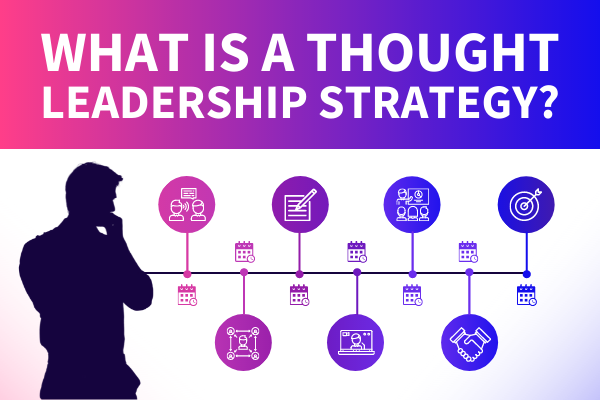When it comes to positioning yourself as a thought leader, there isn’t some magic formula that skyrockets you to success overnight. Instead, it takes dedicated time and energy to make an impact in your space. From standing out from the crowd to showcasing your talent, you need the right thought leadership strategy.
With that in mind, what is a thought leadership strategy? How does this differ from your marketing strategy or content strategy? While there’s often a lot of overlap, these are distinct conceptions. A thought leadership strategy is a type of marketing strategy that specifically focuses on establishing you as the go-to expert in your field.
While anyone can become a thought leader, it still takes real expertise. The internet is full of so-called gurus and experts, but these easily fall through the cracks. Whether you’re trying to build your reputation as a speaker, consultant, or influencer, being seen as a thought leader is a must. It’s true that selling is important, but you have to build a solid foundation first. This is where your thought leadership strategy comes into play.
If you’re still wondering how a thought leadership strategy works and how to get started, you’re in the right place. This guide explores how to build trust and recognition as an expert in your designated industry. There are no quick-fix tricks, but anyone can leverage existing talent and skills to take their thought leadership potential to the next level.
What is thought leadership?
First, what is thought leadership? The definition of thought leadership is always changing, so it can be hard to identify what it is in practice. Contrary to popular belief, it’s not necessarily the loudest person at the conference or the influencer with the most followers. These might be modern versions of the phrase, but they’re far from reality.
Believe it or not, the term “thought leader” has been used since the late 19th century. Henry Ward Beecher, an American minister and social reformer, was first described as a thought leader in 1887, and the word has evolved over time. Today, this term mostly refers to someone who has intellectual influence. This is someone who deeply understands their industry, making a real impact with their ideas and points of view.
Being a thought leader has many benefits as well. When you’re respected in your field as a thought leader, you gain valuable exposure. This not only improves your visibility, but it offers more opportunities for revenue long-term. Here are some of the key benefits of being a thought leader:
- Audience: As a thought leader, you expand your audience to improve your visibility.
- Leads: Thought leadership is also a powerful way to drive new leads. In a way, it’s a form of marketing in itself.
- Trust: Additionally, thought leaders are trusted. This helps you within the sales process.
- Opportunities: When you produce great ideas, you’re offered great opportunities. From speaking engagements to guest posts, each of these appearances adds up to more influence.
- Advantage: Lastly, thought leadership offers a competitive advantage by setting you apart from other professionals or brands.
What is included in a thought leadership strategy?
Next, what exactly is included in a thought leadership strategy? It’s not enough to write “thought leader” in your Twitter bio and call it a day. You need real influence, expertise, and trust to back this up. Let’s take a closer look at what’s included in a thought leadership strategy.
Attention To Industry Trends & Problems
To start, your thought leadership strategy needs to always be based on industry trends and problems. You need to constantly update and educate yourself about your industry and work. Industry problems don’t always stay the same. They’re constantly evolving with technology, social changes, and so on.
The best thought leadership strategies take the time to re-investigate problems or changes. By doing so, you’re always on top of the latest challenges. Staying adaptable is more important than ever, especially in the age of digital innovation. For example, at SpeakerFlow, our team takes a look at industry trends on a quarterly basis so we can better serve our audience.
Social Media Outreach
Second, a thought leadership strategy also needs strong social outreach. While you can be a thought leader no matter how many followers you have, you do need an audience. In today’s world, much of your audience comes from online. With 54% of social media users using platforms to research products and brands, you need to be active online.
However, it’s not enough to post updates and information online without much thought. Rather, you need to be strategic about the platforms you use, the content you post, and how you interact with users. It’s about quality vs. quantity. Simply put, spend time and effort in places your audience spends their time. From there, be an authentic member of the community.
Consistent Content Creation
Third, create content consistently. It’s not enough to post and ghost, creating something and never being seen again. If you want to be seen as a thought leader, you need to create new content regularly. This is how you build awareness around your ideas, insights, and value.
What types of content can you create? The sky’s the limit:
- Blog posts
- Email newsletters
- Videos or webinars
- Podcasts
- Infographics or visual media
- Whitepapers
Consider the type of content your audience looks for online. What are ways you can meet their needs, answer their questions, or add value to their lives? When you create compelling, engaging content, you build real trust with your followers. This translates to real-world social currency.
Collaboration With Industry Thought Leaders
Fourth, your thought leader strategy doesn’t exist in a vacuum. You can’t become a thought leader on your own. You need the help of other industry thought leaders. When you collaborate, you expose yourself and your content to a wider audience. Because their audience sees you associated with this known thought leader, your own standing raises as well.
Collaborating takes many forms. You might guest post on a popular industry blog, or join a panel at a local event. Don’t underestimate the power of networking and putting yourself out there. Each interaction matters, and it’s an opportunity to show your expertise. These connections can help you land paid speaking gigs, book deals, and so much more along the way.
Awareness Of Your Competitors
Fifth, your thought leadership strategy also needs to be aware of your competition. As explained above, you don’t exist in a vacuum. You need to be mindful of your competition, their branding, their content, and what they’re sharing online. While it’s important to stay in your own lane, you also need to find ways to stand out.
If you notice your competitor created a killer ebook, for example, you might find ways you can outshine them. You could create a webinar or course on the topic, lending even more expertise to the space. Learn from your competitors, and don’t be afraid to do better when you can. The better you pay attention to those around you, the more prepared you’ll be to optimize your own strategy.
[hubspot type=cta portal=5815852 id=7cff95fd-a207-455b-aed4-9364f424f159]
How do I build a thought leadership strategy for my business?
With that in mind, how do you build your own thought leadership strategy geared for your business? Once you begin thinking of yourself as a thought leader, you shift the way you market your expertise. However, it’s still useful to have an action plan behind your next steps. These action items below guide you through the process from start to finish.
Start with the “why” behind your thought leadership strategy.
To begin, you need to get to the root of your “why.” This is the foundation for your entire thought leadership strategy. If you don’t know where you’re going or what you’re doing, how can you expect to get anywhere? While you don’t need to go full-on soul searching, consider these questions below:
- Why are you serving your chosen audience?
- What makes you the most qualified expert?
- As my business exists now, what am I known for already?
- What are you most passionate about?
- What challenges will you help your audience solve?
Once you answer these questions, you discover your why. Knowing the influence behind your strategy keeps you motivated, and it also guides your content towards a specific audience. It’s normal if your answers change over time, so don’t be afraid to check in with yourself regularly. Your foundation should always adapt to your strengths and weaknesses, especially as they develop.
Outline the “how” behind your thought leadership strategy.
Next, outline the “how” behind your strategy. In other words, how are you going to achieve your goals? While you now know your objectives and your “why,” you need to set concrete steps. What will you deliver to your audience to help them achieve these goals? It’s not enough to say you’re going to solve a problem without any real-world solution behind it.
The “how” often includes some mix of free and paid content or services. For example, you might offer a free ebook to help new marketers get their brand off the ground. From there, you could offer in-depth consulting or keynote speaking to dive deeper into your key topic areas. Create real-world ways to solve your problems for your audience. Putting your plan into action brings the “how” to life.
Plan a content calendar (and follow it religiously).
Along those lines, you also need to plan a content calendar. This includes content you’ve created yourself (like blog posts, videos, etc.) as well as guest posts and appearances. If you want to build an authentic, engaged following, you need to also be consistent with your posting schedule. Your website and social media profiles should always appear active and engaging. Nobody wants to follow someone who looks like they haven’t updated in months (or more).
There’s no one-size-fits-all when it comes to how often to post, but stay consistent. If this means you interact daily, weekly, or monthly, stick with it. Above all, don’t forget to optimize your posts and website for the web. This means using relevant keywords and keeping your content searchable. Your audience is already searching for you, but you need to make sure you’re discoverable!
Start tracking marketing metrics if you haven’t already.
Last but not least, your thought leadership strategy needs a way to track metrics. Marketing metrics are more than just numbers on a dashboard. They’re a real insight into the success of your campaigns. You need to know which pages on your website get the most traffic, which social posts get the highest engagement, and which keywords are attracting attention. Luckily, there are many analytics tools that handle these things for you. For example, most social platforms have these built-in already.
When you track your metrics, you can optimize the user experience. Not only do you know what your audience wants to see, but you learn more about them. The numbers don’t lie. Follow the data if you want to steadily increase your traffic over time. It’s not enough to hit “publish” on a blog post and expect people to flock to your website. You need to monitor your marketing strategy so you can refine your process.
Build A World Of Influence As A Thought Leader
Ultimately, becoming a thought leader is far from easy. However, in today’s world, thought leaders come from anywhere. Even if you’re just gaining experience in a new industry, you can still position yourself as a thought leader as you continue to grow. Taking the time to build the foundation through your thought leadership strategy makes all the difference.
Whether you’re hoping to be well-versed in your industry or boost your business, becoming a thought leader is a worthwhile goal. Once you know who you are and what you have to offer, you’re ready to build a brand around this. Your authentic desire to help others shines bright, positioning you over the competition. Are you ready to unleash a world of influence? The first step is to just get started.





